Understanding and Leading Change: An Analysis of HMRC's Strategies
VerifiedAdded on 2023/01/10
|16
|4507
|39
Report
AI Summary
This report provides a comprehensive analysis of change management within Her Majesty's Revenue and Customs (HMRC). It begins by comparing HMRC's strategies and operations with those of the Food Standards Agency, highlighting the impact of technological and structural changes driven by both internal and external factors. The report then evaluates how these drivers affect leadership, team dynamics, and individual behaviors, offering insights into how HMRC manages customer service, employee roles, and communication. Furthermore, it assesses measures to minimize the negative impacts of change, such as employee resistance and process inefficiencies, emphasizing the crucial role of leadership in fostering employee engagement and satisfaction. The analysis includes the application of force field analysis to understand driving and resisting forces influencing decision-making, and concludes by examining various leadership approaches used to navigate change in different organizational contexts, evaluating their effectiveness in delivering organizational change. The report emphasizes the importance of adapting to change to ensure the survival and growth of the business.
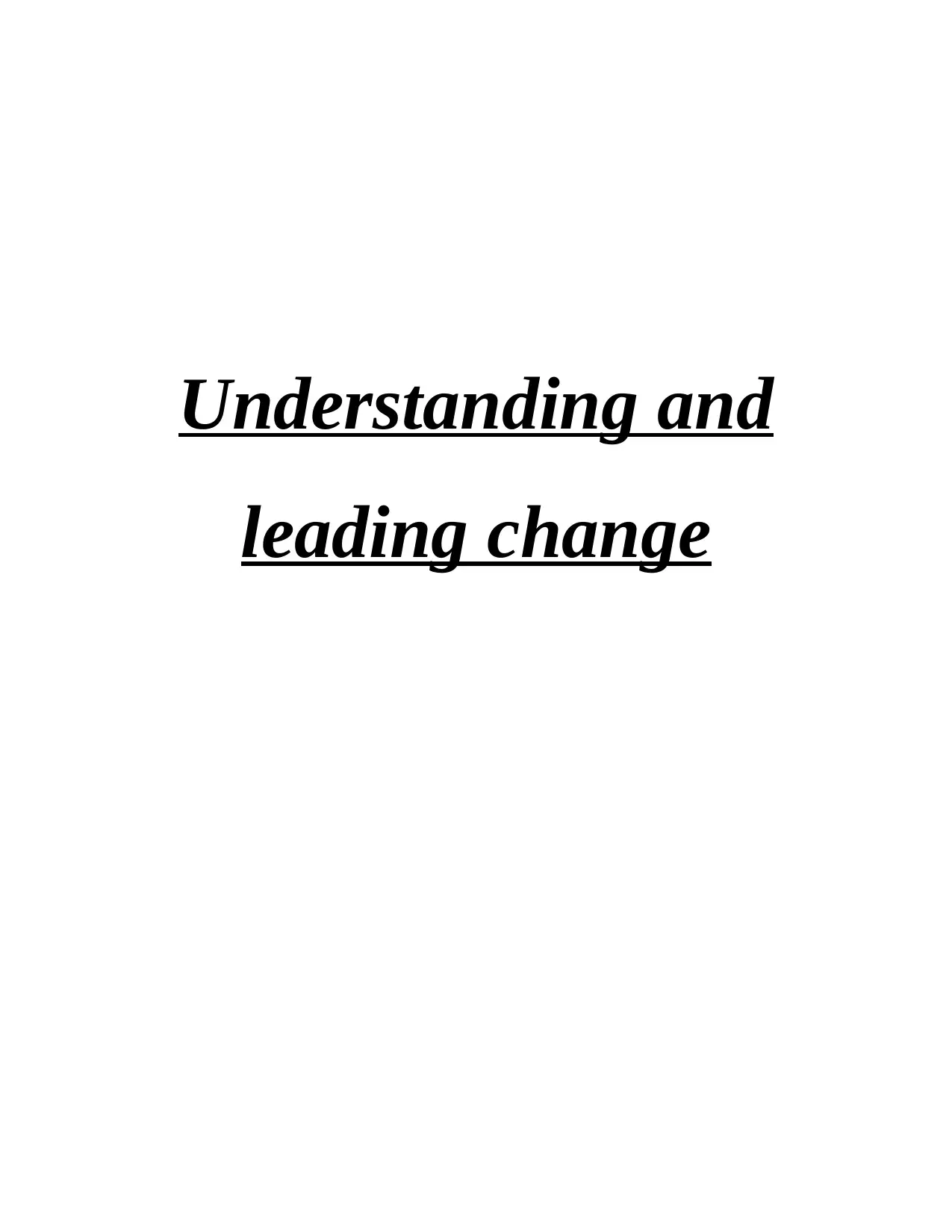
Understanding and
leading change
leading change
Paraphrase This Document
Need a fresh take? Get an instant paraphrase of this document with our AI Paraphraser
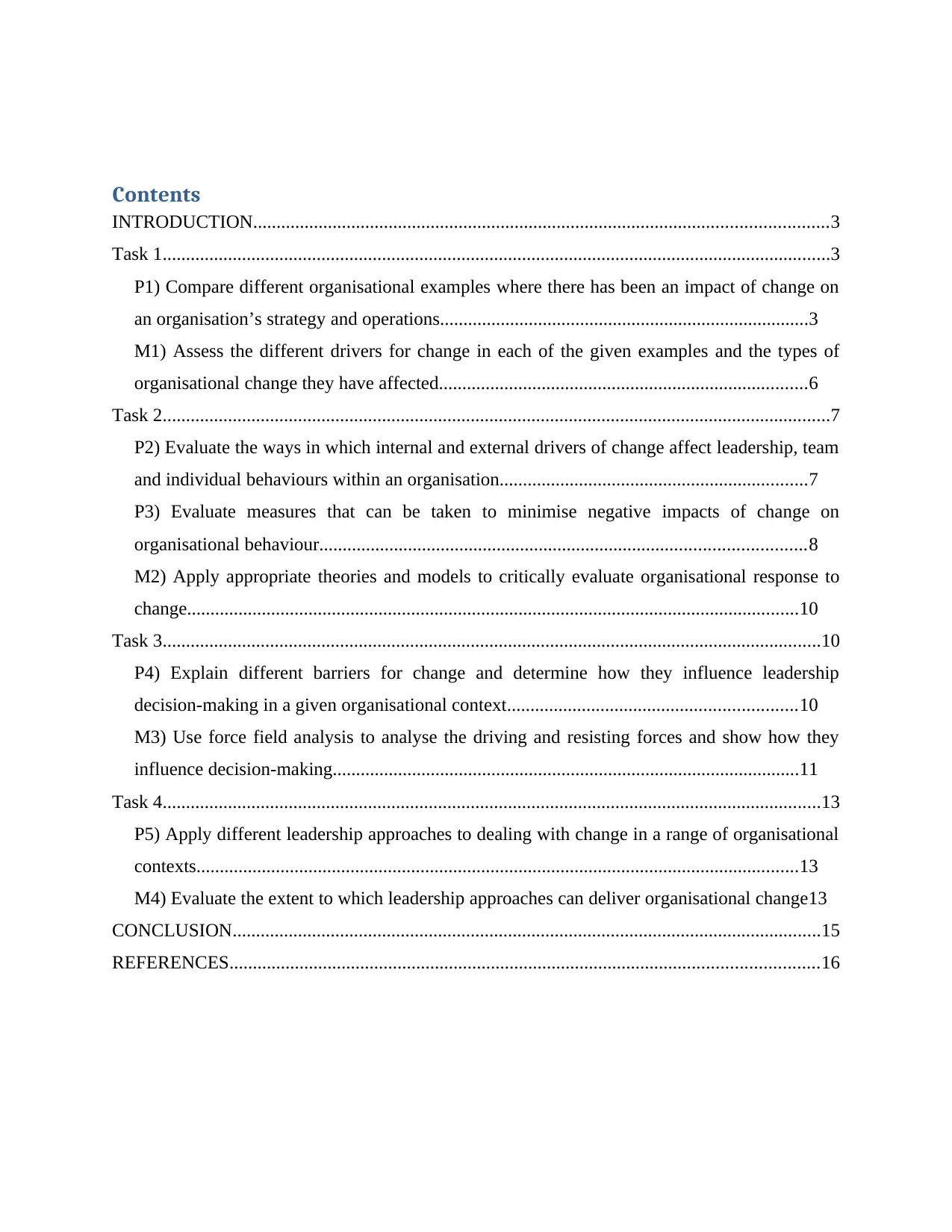
Contents
INTRODUCTION...........................................................................................................................3
Task 1...............................................................................................................................................3
P1) Compare different organisational examples where there has been an impact of change on
an organisation’s strategy and operations...............................................................................3
M1) Assess the different drivers for change in each of the given examples and the types of
organisational change they have affected...............................................................................6
Task 2...............................................................................................................................................7
P2) Evaluate the ways in which internal and external drivers of change affect leadership, team
and individual behaviours within an organisation..................................................................7
P3) Evaluate measures that can be taken to minimise negative impacts of change on
organisational behaviour........................................................................................................8
M2) Apply appropriate theories and models to critically evaluate organisational response to
change...................................................................................................................................10
Task 3.............................................................................................................................................10
P4) Explain different barriers for change and determine how they influence leadership
decision-making in a given organisational context..............................................................10
M3) Use force field analysis to analyse the driving and resisting forces and show how they
influence decision-making....................................................................................................11
Task 4.............................................................................................................................................13
P5) Apply different leadership approaches to dealing with change in a range of organisational
contexts.................................................................................................................................13
M4) Evaluate the extent to which leadership approaches can deliver organisational change13
CONCLUSION..............................................................................................................................15
REFERENCES..............................................................................................................................16
INTRODUCTION...........................................................................................................................3
Task 1...............................................................................................................................................3
P1) Compare different organisational examples where there has been an impact of change on
an organisation’s strategy and operations...............................................................................3
M1) Assess the different drivers for change in each of the given examples and the types of
organisational change they have affected...............................................................................6
Task 2...............................................................................................................................................7
P2) Evaluate the ways in which internal and external drivers of change affect leadership, team
and individual behaviours within an organisation..................................................................7
P3) Evaluate measures that can be taken to minimise negative impacts of change on
organisational behaviour........................................................................................................8
M2) Apply appropriate theories and models to critically evaluate organisational response to
change...................................................................................................................................10
Task 3.............................................................................................................................................10
P4) Explain different barriers for change and determine how they influence leadership
decision-making in a given organisational context..............................................................10
M3) Use force field analysis to analyse the driving and resisting forces and show how they
influence decision-making....................................................................................................11
Task 4.............................................................................................................................................13
P5) Apply different leadership approaches to dealing with change in a range of organisational
contexts.................................................................................................................................13
M4) Evaluate the extent to which leadership approaches can deliver organisational change13
CONCLUSION..............................................................................................................................15
REFERENCES..............................................................................................................................16
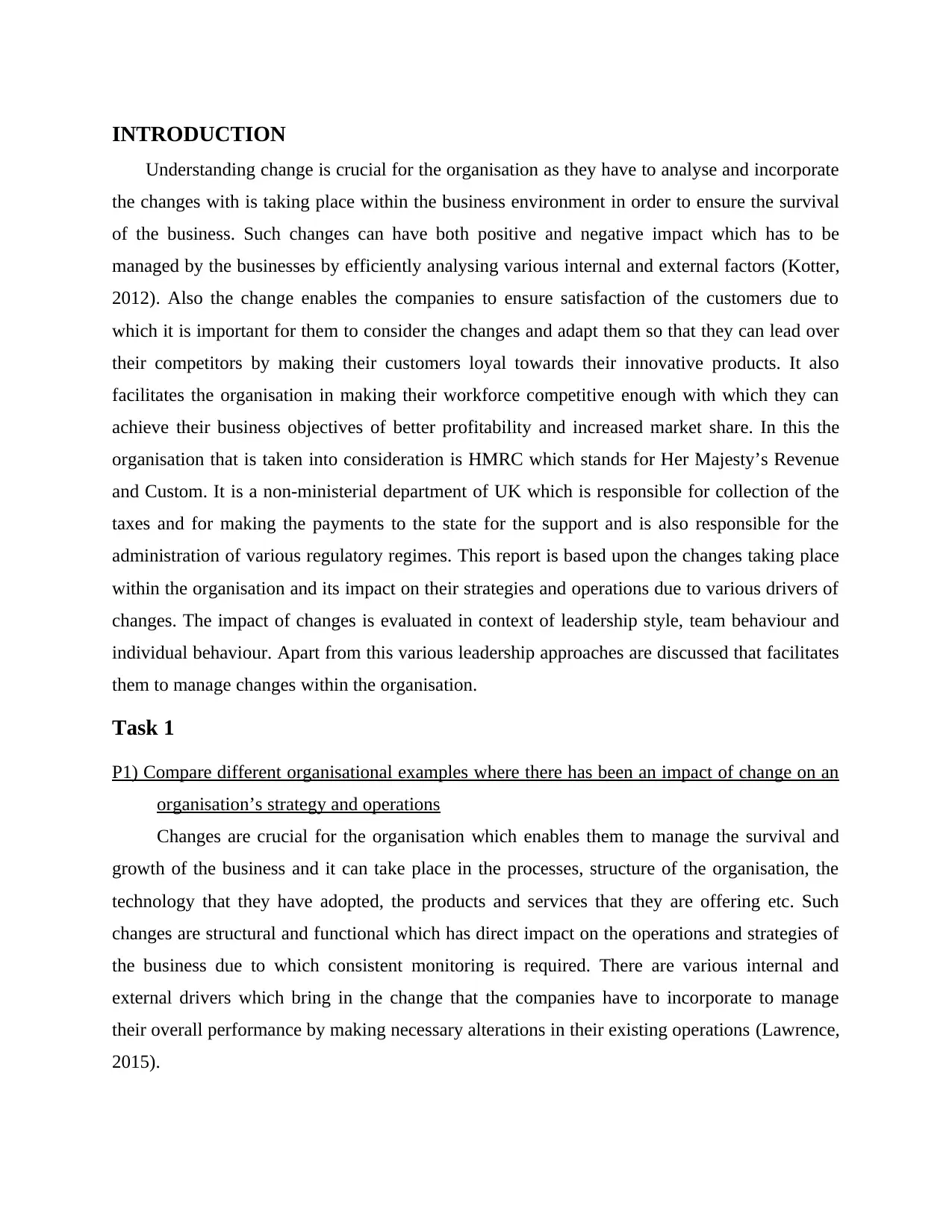
INTRODUCTION
Understanding change is crucial for the organisation as they have to analyse and incorporate
the changes with is taking place within the business environment in order to ensure the survival
of the business. Such changes can have both positive and negative impact which has to be
managed by the businesses by efficiently analysing various internal and external factors (Kotter,
2012). Also the change enables the companies to ensure satisfaction of the customers due to
which it is important for them to consider the changes and adapt them so that they can lead over
their competitors by making their customers loyal towards their innovative products. It also
facilitates the organisation in making their workforce competitive enough with which they can
achieve their business objectives of better profitability and increased market share. In this the
organisation that is taken into consideration is HMRC which stands for Her Majesty’s Revenue
and Custom. It is a non-ministerial department of UK which is responsible for collection of the
taxes and for making the payments to the state for the support and is also responsible for the
administration of various regulatory regimes. This report is based upon the changes taking place
within the organisation and its impact on their strategies and operations due to various drivers of
changes. The impact of changes is evaluated in context of leadership style, team behaviour and
individual behaviour. Apart from this various leadership approaches are discussed that facilitates
them to manage changes within the organisation.
Task 1
P1) Compare different organisational examples where there has been an impact of change on an
organisation’s strategy and operations
Changes are crucial for the organisation which enables them to manage the survival and
growth of the business and it can take place in the processes, structure of the organisation, the
technology that they have adopted, the products and services that they are offering etc. Such
changes are structural and functional which has direct impact on the operations and strategies of
the business due to which consistent monitoring is required. There are various internal and
external drivers which bring in the change that the companies have to incorporate to manage
their overall performance by making necessary alterations in their existing operations (Lawrence,
2015).
Understanding change is crucial for the organisation as they have to analyse and incorporate
the changes with is taking place within the business environment in order to ensure the survival
of the business. Such changes can have both positive and negative impact which has to be
managed by the businesses by efficiently analysing various internal and external factors (Kotter,
2012). Also the change enables the companies to ensure satisfaction of the customers due to
which it is important for them to consider the changes and adapt them so that they can lead over
their competitors by making their customers loyal towards their innovative products. It also
facilitates the organisation in making their workforce competitive enough with which they can
achieve their business objectives of better profitability and increased market share. In this the
organisation that is taken into consideration is HMRC which stands for Her Majesty’s Revenue
and Custom. It is a non-ministerial department of UK which is responsible for collection of the
taxes and for making the payments to the state for the support and is also responsible for the
administration of various regulatory regimes. This report is based upon the changes taking place
within the organisation and its impact on their strategies and operations due to various drivers of
changes. The impact of changes is evaluated in context of leadership style, team behaviour and
individual behaviour. Apart from this various leadership approaches are discussed that facilitates
them to manage changes within the organisation.
Task 1
P1) Compare different organisational examples where there has been an impact of change on an
organisation’s strategy and operations
Changes are crucial for the organisation which enables them to manage the survival and
growth of the business and it can take place in the processes, structure of the organisation, the
technology that they have adopted, the products and services that they are offering etc. Such
changes are structural and functional which has direct impact on the operations and strategies of
the business due to which consistent monitoring is required. There are various internal and
external drivers which bring in the change that the companies have to incorporate to manage
their overall performance by making necessary alterations in their existing operations (Lawrence,
2015).
⊘ This is a preview!⊘
Do you want full access?
Subscribe today to unlock all pages.

Trusted by 1+ million students worldwide
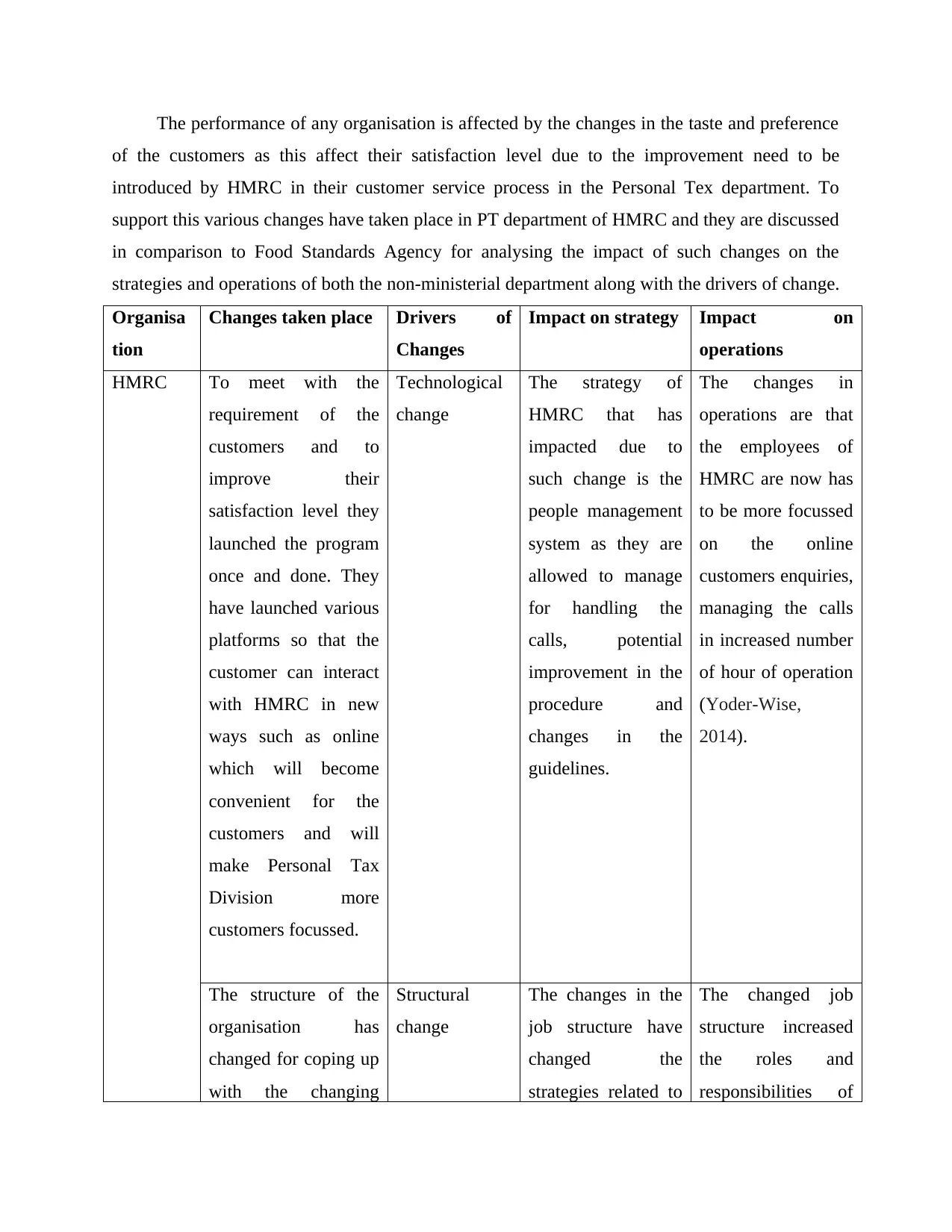
The performance of any organisation is affected by the changes in the taste and preference
of the customers as this affect their satisfaction level due to the improvement need to be
introduced by HMRC in their customer service process in the Personal Tex department. To
support this various changes have taken place in PT department of HMRC and they are discussed
in comparison to Food Standards Agency for analysing the impact of such changes on the
strategies and operations of both the non-ministerial department along with the drivers of change.
Organisa
tion
Changes taken place Drivers of
Changes
Impact on strategy Impact on
operations
HMRC To meet with the
requirement of the
customers and to
improve their
satisfaction level they
launched the program
once and done. They
have launched various
platforms so that the
customer can interact
with HMRC in new
ways such as online
which will become
convenient for the
customers and will
make Personal Tax
Division more
customers focussed.
Technological
change
The strategy of
HMRC that has
impacted due to
such change is the
people management
system as they are
allowed to manage
for handling the
calls, potential
improvement in the
procedure and
changes in the
guidelines.
The changes in
operations are that
the employees of
HMRC are now has
to be more focussed
on the online
customers enquiries,
managing the calls
in increased number
of hour of operation
(Yoder-Wise,
2014).
The structure of the
organisation has
changed for coping up
with the changing
Structural
change
The changes in the
job structure have
changed the
strategies related to
The changed job
structure increased
the roles and
responsibilities of
of the customers as this affect their satisfaction level due to the improvement need to be
introduced by HMRC in their customer service process in the Personal Tex department. To
support this various changes have taken place in PT department of HMRC and they are discussed
in comparison to Food Standards Agency for analysing the impact of such changes on the
strategies and operations of both the non-ministerial department along with the drivers of change.
Organisa
tion
Changes taken place Drivers of
Changes
Impact on strategy Impact on
operations
HMRC To meet with the
requirement of the
customers and to
improve their
satisfaction level they
launched the program
once and done. They
have launched various
platforms so that the
customer can interact
with HMRC in new
ways such as online
which will become
convenient for the
customers and will
make Personal Tax
Division more
customers focussed.
Technological
change
The strategy of
HMRC that has
impacted due to
such change is the
people management
system as they are
allowed to manage
for handling the
calls, potential
improvement in the
procedure and
changes in the
guidelines.
The changes in
operations are that
the employees of
HMRC are now has
to be more focussed
on the online
customers enquiries,
managing the calls
in increased number
of hour of operation
(Yoder-Wise,
2014).
The structure of the
organisation has
changed for coping up
with the changing
Structural
change
The changes in the
job structure have
changed the
strategies related to
The changed job
structure increased
the roles and
responsibilities of
Paraphrase This Document
Need a fresh take? Get an instant paraphrase of this document with our AI Paraphraser
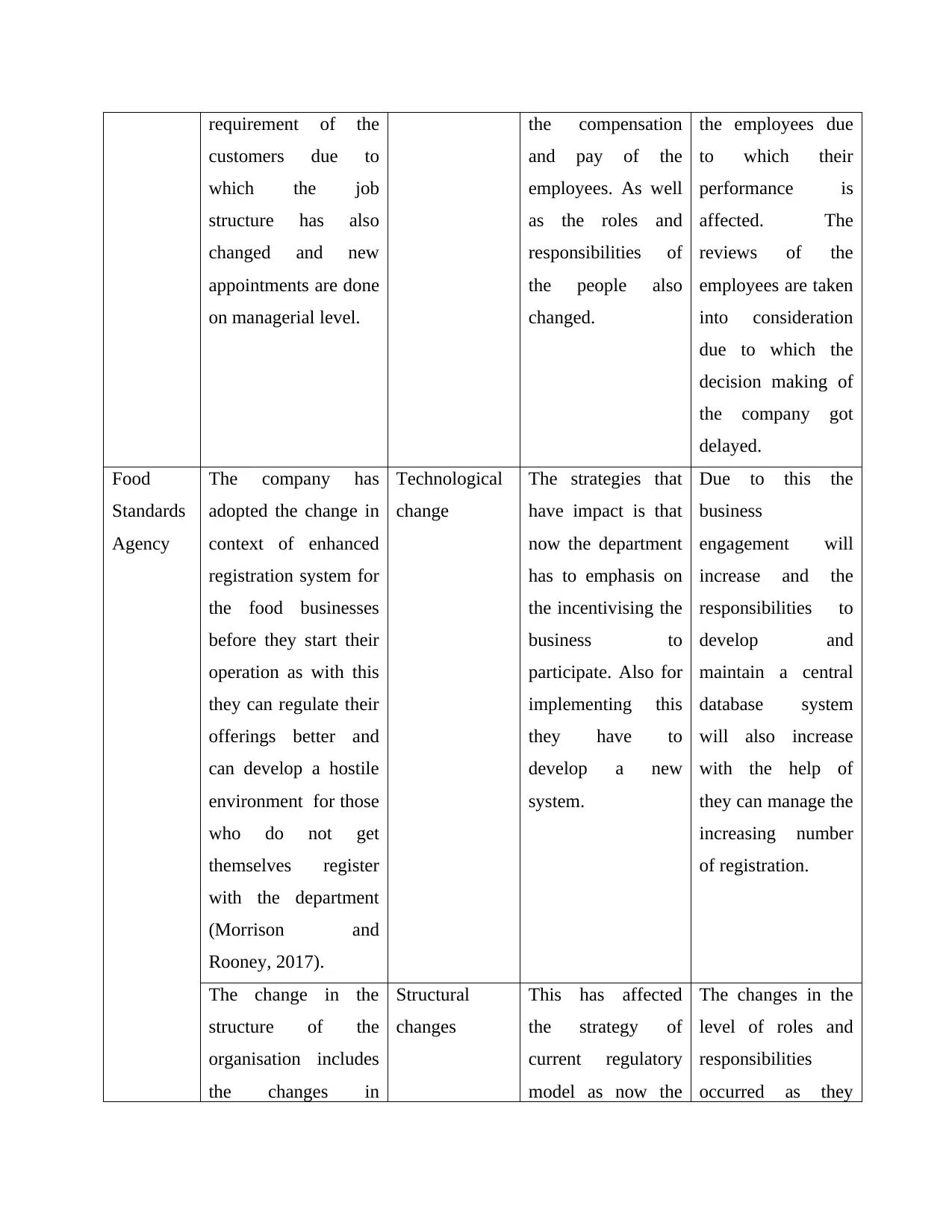
requirement of the
customers due to
which the job
structure has also
changed and new
appointments are done
on managerial level.
the compensation
and pay of the
employees. As well
as the roles and
responsibilities of
the people also
changed.
the employees due
to which their
performance is
affected. The
reviews of the
employees are taken
into consideration
due to which the
decision making of
the company got
delayed.
Food
Standards
Agency
The company has
adopted the change in
context of enhanced
registration system for
the food businesses
before they start their
operation as with this
they can regulate their
offerings better and
can develop a hostile
environment for those
who do not get
themselves register
with the department
(Morrison and
Rooney, 2017).
Technological
change
The strategies that
have impact is that
now the department
has to emphasis on
the incentivising the
business to
participate. Also for
implementing this
they have to
develop a new
system.
Due to this the
business
engagement will
increase and the
responsibilities to
develop and
maintain a central
database system
will also increase
with the help of
they can manage the
increasing number
of registration.
The change in the
structure of the
organisation includes
the changes in
Structural
changes
This has affected
the strategy of
current regulatory
model as now the
The changes in the
level of roles and
responsibilities
occurred as they
customers due to
which the job
structure has also
changed and new
appointments are done
on managerial level.
the compensation
and pay of the
employees. As well
as the roles and
responsibilities of
the people also
changed.
the employees due
to which their
performance is
affected. The
reviews of the
employees are taken
into consideration
due to which the
decision making of
the company got
delayed.
Food
Standards
Agency
The company has
adopted the change in
context of enhanced
registration system for
the food businesses
before they start their
operation as with this
they can regulate their
offerings better and
can develop a hostile
environment for those
who do not get
themselves register
with the department
(Morrison and
Rooney, 2017).
Technological
change
The strategies that
have impact is that
now the department
has to emphasis on
the incentivising the
business to
participate. Also for
implementing this
they have to
develop a new
system.
Due to this the
business
engagement will
increase and the
responsibilities to
develop and
maintain a central
database system
will also increase
with the help of
they can manage the
increasing number
of registration.
The change in the
structure of the
organisation includes
the changes in
Structural
changes
This has affected
the strategy of
current regulatory
model as now the
The changes in the
level of roles and
responsibilities
occurred as they
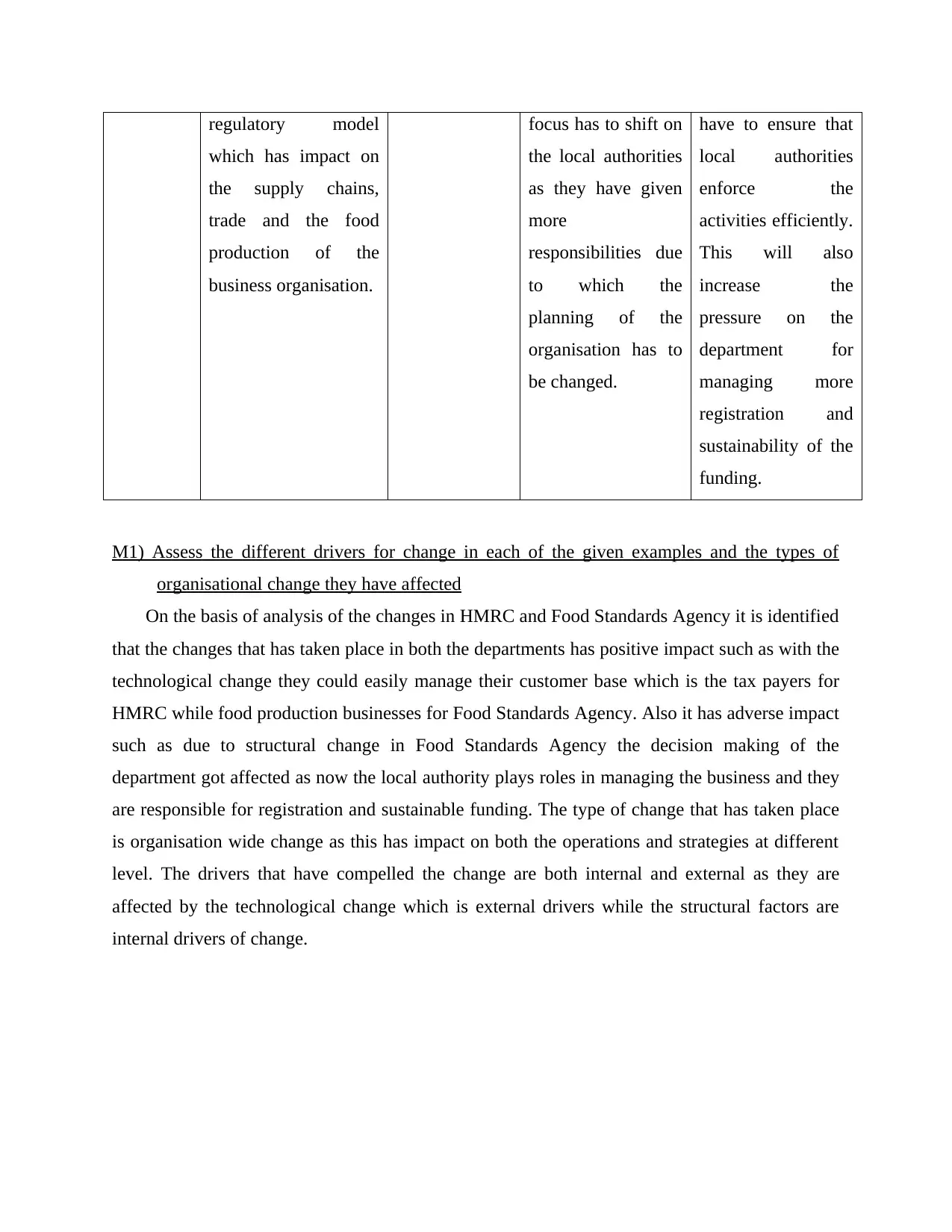
regulatory model
which has impact on
the supply chains,
trade and the food
production of the
business organisation.
focus has to shift on
the local authorities
as they have given
more
responsibilities due
to which the
planning of the
organisation has to
be changed.
have to ensure that
local authorities
enforce the
activities efficiently.
This will also
increase the
pressure on the
department for
managing more
registration and
sustainability of the
funding.
M1) Assess the different drivers for change in each of the given examples and the types of
organisational change they have affected
On the basis of analysis of the changes in HMRC and Food Standards Agency it is identified
that the changes that has taken place in both the departments has positive impact such as with the
technological change they could easily manage their customer base which is the tax payers for
HMRC while food production businesses for Food Standards Agency. Also it has adverse impact
such as due to structural change in Food Standards Agency the decision making of the
department got affected as now the local authority plays roles in managing the business and they
are responsible for registration and sustainable funding. The type of change that has taken place
is organisation wide change as this has impact on both the operations and strategies at different
level. The drivers that have compelled the change are both internal and external as they are
affected by the technological change which is external drivers while the structural factors are
internal drivers of change.
which has impact on
the supply chains,
trade and the food
production of the
business organisation.
focus has to shift on
the local authorities
as they have given
more
responsibilities due
to which the
planning of the
organisation has to
be changed.
have to ensure that
local authorities
enforce the
activities efficiently.
This will also
increase the
pressure on the
department for
managing more
registration and
sustainability of the
funding.
M1) Assess the different drivers for change in each of the given examples and the types of
organisational change they have affected
On the basis of analysis of the changes in HMRC and Food Standards Agency it is identified
that the changes that has taken place in both the departments has positive impact such as with the
technological change they could easily manage their customer base which is the tax payers for
HMRC while food production businesses for Food Standards Agency. Also it has adverse impact
such as due to structural change in Food Standards Agency the decision making of the
department got affected as now the local authority plays roles in managing the business and they
are responsible for registration and sustainable funding. The type of change that has taken place
is organisation wide change as this has impact on both the operations and strategies at different
level. The drivers that have compelled the change are both internal and external as they are
affected by the technological change which is external drivers while the structural factors are
internal drivers of change.
⊘ This is a preview!⊘
Do you want full access?
Subscribe today to unlock all pages.

Trusted by 1+ million students worldwide
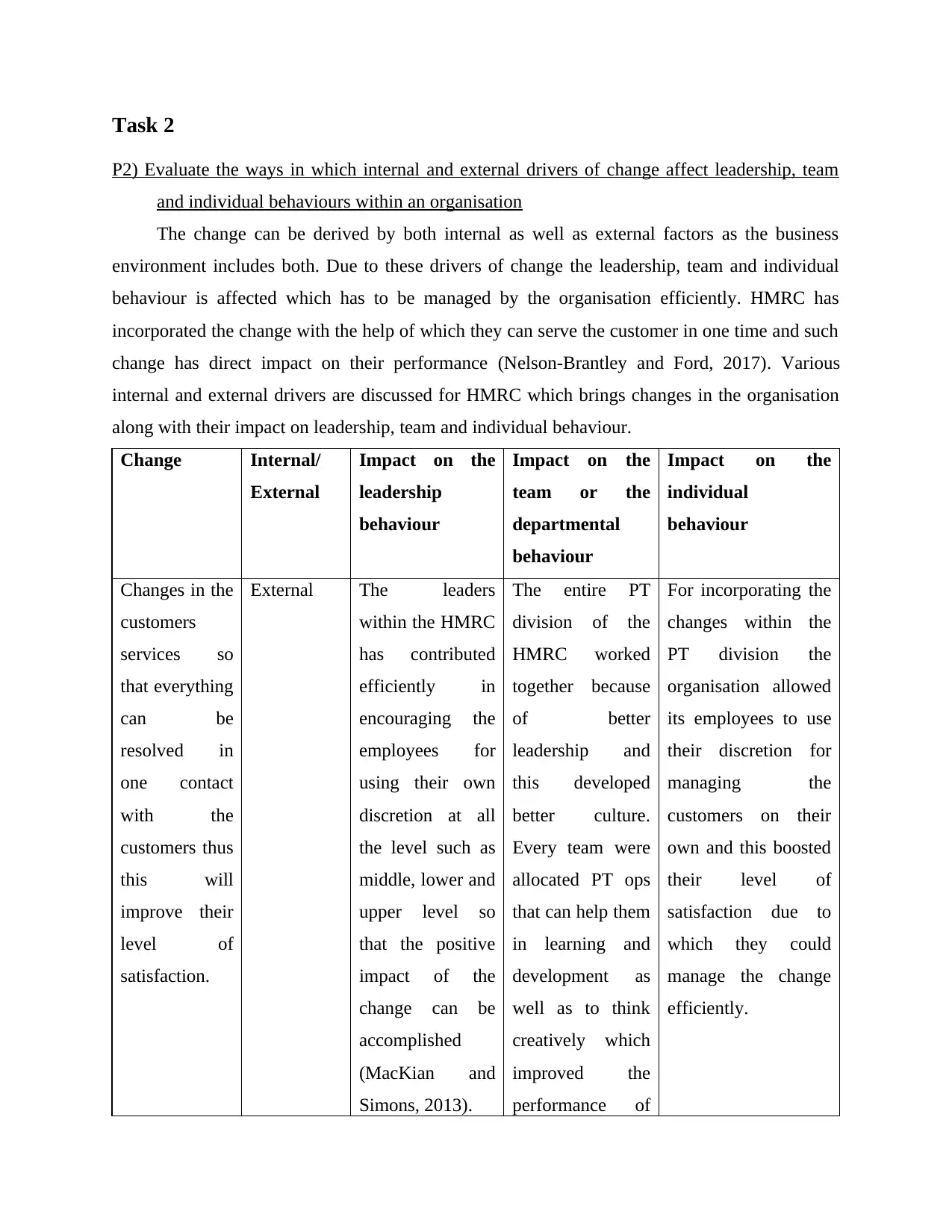
Task 2
P2) Evaluate the ways in which internal and external drivers of change affect leadership, team
and individual behaviours within an organisation
The change can be derived by both internal as well as external factors as the business
environment includes both. Due to these drivers of change the leadership, team and individual
behaviour is affected which has to be managed by the organisation efficiently. HMRC has
incorporated the change with the help of which they can serve the customer in one time and such
change has direct impact on their performance (Nelson‐Brantley and Ford, 2017). Various
internal and external drivers are discussed for HMRC which brings changes in the organisation
along with their impact on leadership, team and individual behaviour.
Change Internal/
External
Impact on the
leadership
behaviour
Impact on the
team or the
departmental
behaviour
Impact on the
individual
behaviour
Changes in the
customers
services so
that everything
can be
resolved in
one contact
with the
customers thus
this will
improve their
level of
satisfaction.
External The leaders
within the HMRC
has contributed
efficiently in
encouraging the
employees for
using their own
discretion at all
the level such as
middle, lower and
upper level so
that the positive
impact of the
change can be
accomplished
(MacKian and
Simons, 2013).
The entire PT
division of the
HMRC worked
together because
of better
leadership and
this developed
better culture.
Every team were
allocated PT ops
that can help them
in learning and
development as
well as to think
creatively which
improved the
performance of
For incorporating the
changes within the
PT division the
organisation allowed
its employees to use
their discretion for
managing the
customers on their
own and this boosted
their level of
satisfaction due to
which they could
manage the change
efficiently.
P2) Evaluate the ways in which internal and external drivers of change affect leadership, team
and individual behaviours within an organisation
The change can be derived by both internal as well as external factors as the business
environment includes both. Due to these drivers of change the leadership, team and individual
behaviour is affected which has to be managed by the organisation efficiently. HMRC has
incorporated the change with the help of which they can serve the customer in one time and such
change has direct impact on their performance (Nelson‐Brantley and Ford, 2017). Various
internal and external drivers are discussed for HMRC which brings changes in the organisation
along with their impact on leadership, team and individual behaviour.
Change Internal/
External
Impact on the
leadership
behaviour
Impact on the
team or the
departmental
behaviour
Impact on the
individual
behaviour
Changes in the
customers
services so
that everything
can be
resolved in
one contact
with the
customers thus
this will
improve their
level of
satisfaction.
External The leaders
within the HMRC
has contributed
efficiently in
encouraging the
employees for
using their own
discretion at all
the level such as
middle, lower and
upper level so
that the positive
impact of the
change can be
accomplished
(MacKian and
Simons, 2013).
The entire PT
division of the
HMRC worked
together because
of better
leadership and
this developed
better culture.
Every team were
allocated PT ops
that can help them
in learning and
development as
well as to think
creatively which
improved the
performance of
For incorporating the
changes within the
PT division the
organisation allowed
its employees to use
their discretion for
managing the
customers on their
own and this boosted
their level of
satisfaction due to
which they could
manage the change
efficiently.
Paraphrase This Document
Need a fresh take? Get an instant paraphrase of this document with our AI Paraphraser
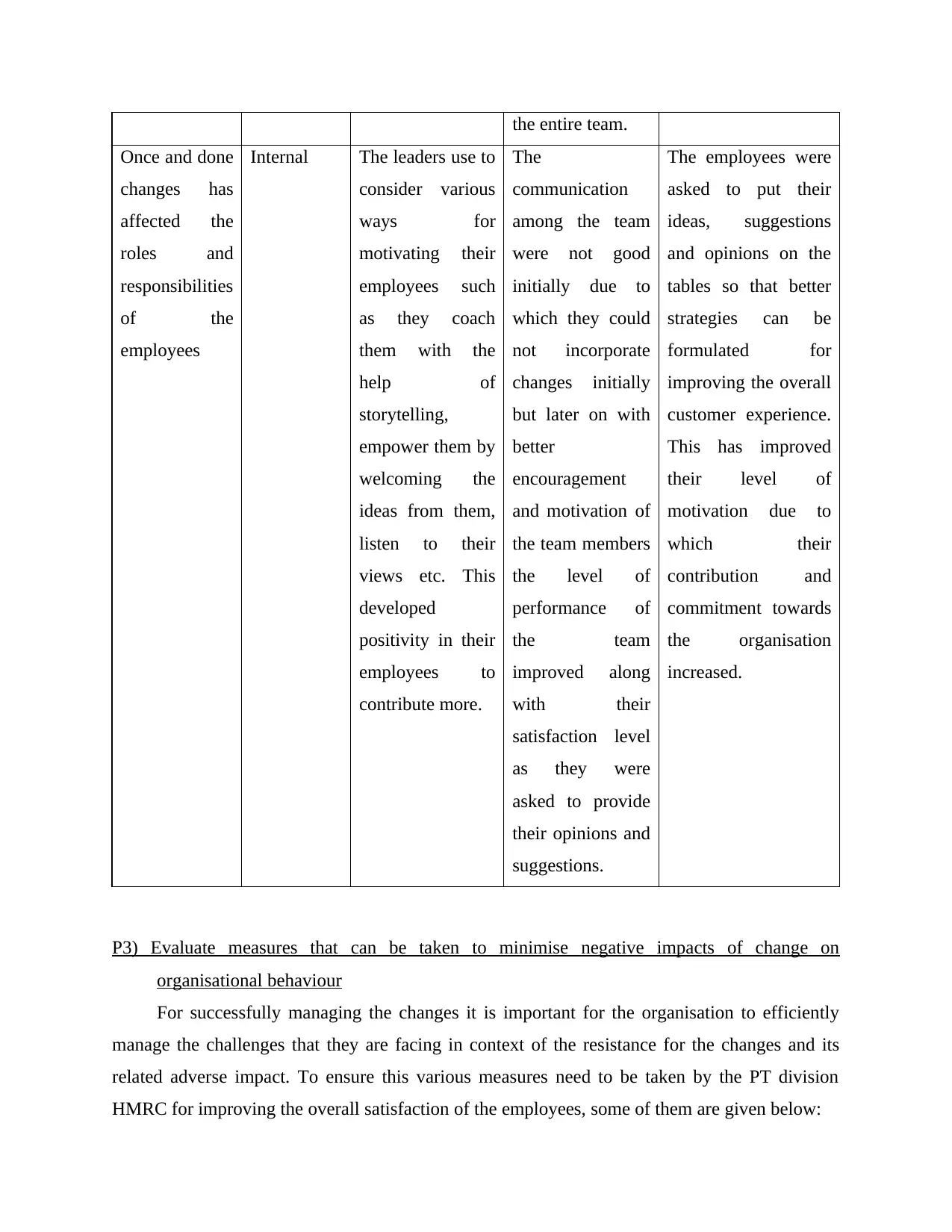
the entire team.
Once and done
changes has
affected the
roles and
responsibilities
of the
employees
Internal The leaders use to
consider various
ways for
motivating their
employees such
as they coach
them with the
help of
storytelling,
empower them by
welcoming the
ideas from them,
listen to their
views etc. This
developed
positivity in their
employees to
contribute more.
The
communication
among the team
were not good
initially due to
which they could
not incorporate
changes initially
but later on with
better
encouragement
and motivation of
the team members
the level of
performance of
the team
improved along
with their
satisfaction level
as they were
asked to provide
their opinions and
suggestions.
The employees were
asked to put their
ideas, suggestions
and opinions on the
tables so that better
strategies can be
formulated for
improving the overall
customer experience.
This has improved
their level of
motivation due to
which their
contribution and
commitment towards
the organisation
increased.
P3) Evaluate measures that can be taken to minimise negative impacts of change on
organisational behaviour
For successfully managing the changes it is important for the organisation to efficiently
manage the challenges that they are facing in context of the resistance for the changes and its
related adverse impact. To ensure this various measures need to be taken by the PT division
HMRC for improving the overall satisfaction of the employees, some of them are given below:
Once and done
changes has
affected the
roles and
responsibilities
of the
employees
Internal The leaders use to
consider various
ways for
motivating their
employees such
as they coach
them with the
help of
storytelling,
empower them by
welcoming the
ideas from them,
listen to their
views etc. This
developed
positivity in their
employees to
contribute more.
The
communication
among the team
were not good
initially due to
which they could
not incorporate
changes initially
but later on with
better
encouragement
and motivation of
the team members
the level of
performance of
the team
improved along
with their
satisfaction level
as they were
asked to provide
their opinions and
suggestions.
The employees were
asked to put their
ideas, suggestions
and opinions on the
tables so that better
strategies can be
formulated for
improving the overall
customer experience.
This has improved
their level of
motivation due to
which their
contribution and
commitment towards
the organisation
increased.
P3) Evaluate measures that can be taken to minimise negative impacts of change on
organisational behaviour
For successfully managing the changes it is important for the organisation to efficiently
manage the challenges that they are facing in context of the resistance for the changes and its
related adverse impact. To ensure this various measures need to be taken by the PT division
HMRC for improving the overall satisfaction of the employees, some of them are given below:
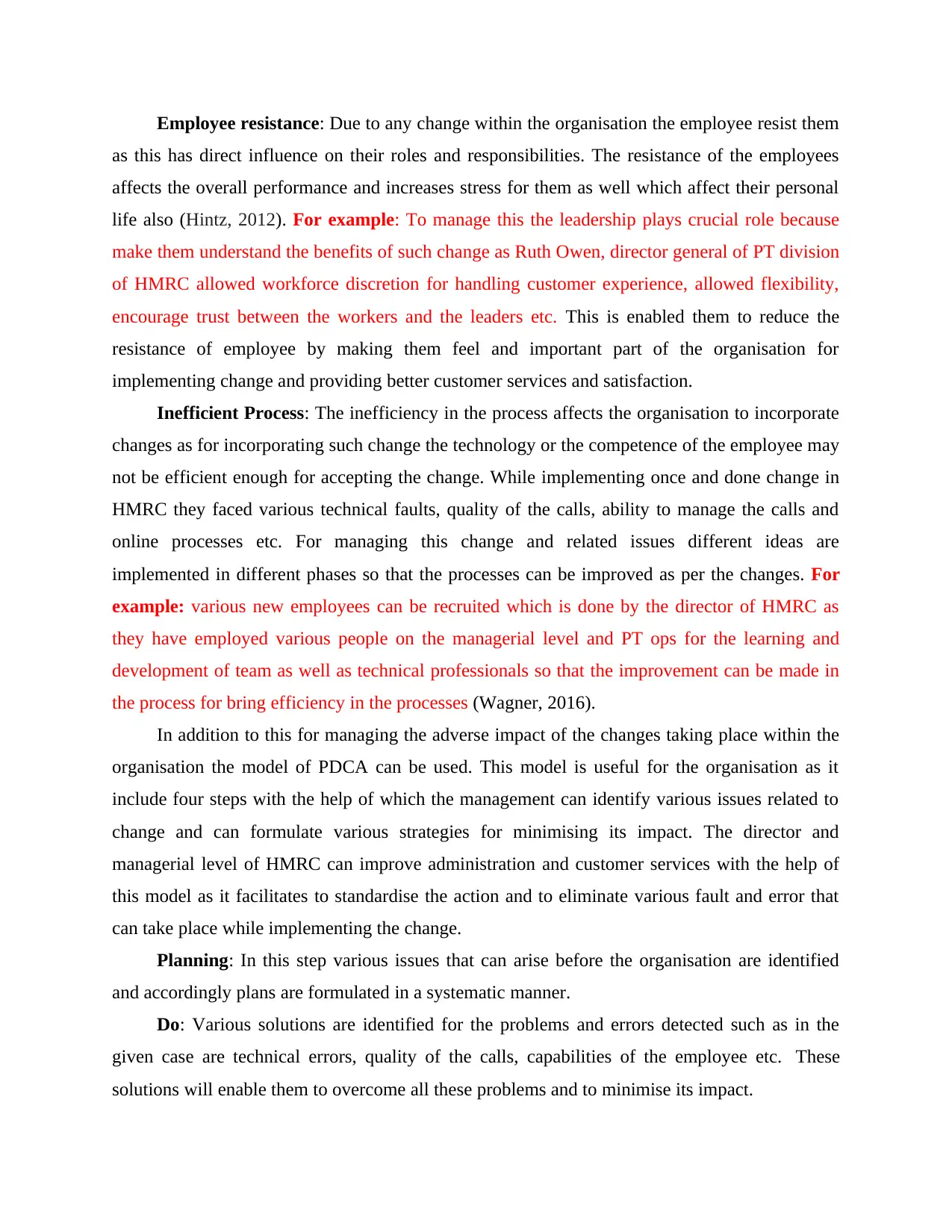
Employee resistance: Due to any change within the organisation the employee resist them
as this has direct influence on their roles and responsibilities. The resistance of the employees
affects the overall performance and increases stress for them as well which affect their personal
life also (Hintz, 2012). For example: To manage this the leadership plays crucial role because
make them understand the benefits of such change as Ruth Owen, director general of PT division
of HMRC allowed workforce discretion for handling customer experience, allowed flexibility,
encourage trust between the workers and the leaders etc. This is enabled them to reduce the
resistance of employee by making them feel and important part of the organisation for
implementing change and providing better customer services and satisfaction.
Inefficient Process: The inefficiency in the process affects the organisation to incorporate
changes as for incorporating such change the technology or the competence of the employee may
not be efficient enough for accepting the change. While implementing once and done change in
HMRC they faced various technical faults, quality of the calls, ability to manage the calls and
online processes etc. For managing this change and related issues different ideas are
implemented in different phases so that the processes can be improved as per the changes. For
example: various new employees can be recruited which is done by the director of HMRC as
they have employed various people on the managerial level and PT ops for the learning and
development of team as well as technical professionals so that the improvement can be made in
the process for bring efficiency in the processes (Wagner, 2016).
In addition to this for managing the adverse impact of the changes taking place within the
organisation the model of PDCA can be used. This model is useful for the organisation as it
include four steps with the help of which the management can identify various issues related to
change and can formulate various strategies for minimising its impact. The director and
managerial level of HMRC can improve administration and customer services with the help of
this model as it facilitates to standardise the action and to eliminate various fault and error that
can take place while implementing the change.
Planning: In this step various issues that can arise before the organisation are identified
and accordingly plans are formulated in a systematic manner.
Do: Various solutions are identified for the problems and errors detected such as in the
given case are technical errors, quality of the calls, capabilities of the employee etc. These
solutions will enable them to overcome all these problems and to minimise its impact.
as this has direct influence on their roles and responsibilities. The resistance of the employees
affects the overall performance and increases stress for them as well which affect their personal
life also (Hintz, 2012). For example: To manage this the leadership plays crucial role because
make them understand the benefits of such change as Ruth Owen, director general of PT division
of HMRC allowed workforce discretion for handling customer experience, allowed flexibility,
encourage trust between the workers and the leaders etc. This is enabled them to reduce the
resistance of employee by making them feel and important part of the organisation for
implementing change and providing better customer services and satisfaction.
Inefficient Process: The inefficiency in the process affects the organisation to incorporate
changes as for incorporating such change the technology or the competence of the employee may
not be efficient enough for accepting the change. While implementing once and done change in
HMRC they faced various technical faults, quality of the calls, ability to manage the calls and
online processes etc. For managing this change and related issues different ideas are
implemented in different phases so that the processes can be improved as per the changes. For
example: various new employees can be recruited which is done by the director of HMRC as
they have employed various people on the managerial level and PT ops for the learning and
development of team as well as technical professionals so that the improvement can be made in
the process for bring efficiency in the processes (Wagner, 2016).
In addition to this for managing the adverse impact of the changes taking place within the
organisation the model of PDCA can be used. This model is useful for the organisation as it
include four steps with the help of which the management can identify various issues related to
change and can formulate various strategies for minimising its impact. The director and
managerial level of HMRC can improve administration and customer services with the help of
this model as it facilitates to standardise the action and to eliminate various fault and error that
can take place while implementing the change.
Planning: In this step various issues that can arise before the organisation are identified
and accordingly plans are formulated in a systematic manner.
Do: Various solutions are identified for the problems and errors detected such as in the
given case are technical errors, quality of the calls, capabilities of the employee etc. These
solutions will enable them to overcome all these problems and to minimise its impact.
⊘ This is a preview!⊘
Do you want full access?
Subscribe today to unlock all pages.

Trusted by 1+ million students worldwide
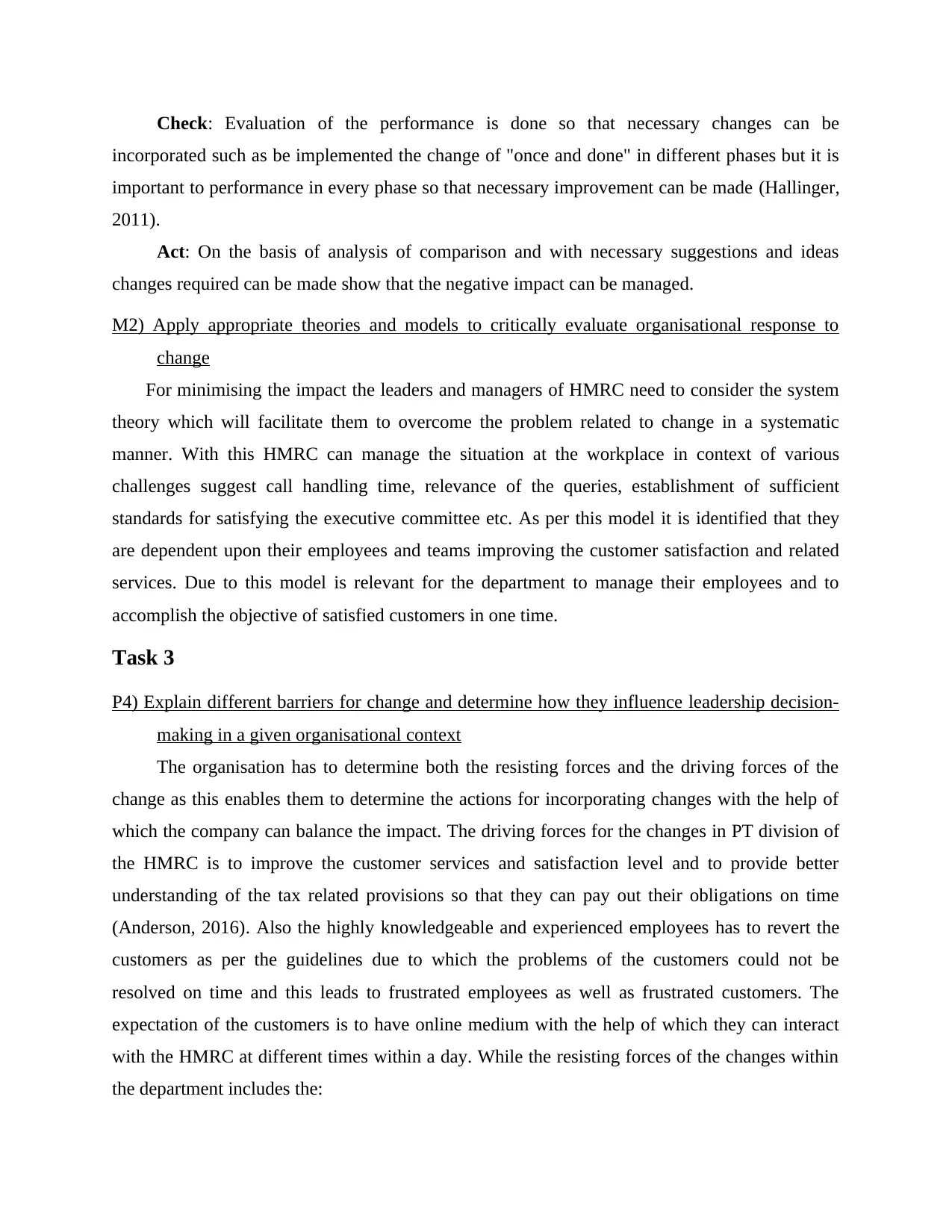
Check: Evaluation of the performance is done so that necessary changes can be
incorporated such as be implemented the change of "once and done" in different phases but it is
important to performance in every phase so that necessary improvement can be made (Hallinger,
2011).
Act: On the basis of analysis of comparison and with necessary suggestions and ideas
changes required can be made show that the negative impact can be managed.
M2) Apply appropriate theories and models to critically evaluate organisational response to
change
For minimising the impact the leaders and managers of HMRC need to consider the system
theory which will facilitate them to overcome the problem related to change in a systematic
manner. With this HMRC can manage the situation at the workplace in context of various
challenges suggest call handling time, relevance of the queries, establishment of sufficient
standards for satisfying the executive committee etc. As per this model it is identified that they
are dependent upon their employees and teams improving the customer satisfaction and related
services. Due to this model is relevant for the department to manage their employees and to
accomplish the objective of satisfied customers in one time.
Task 3
P4) Explain different barriers for change and determine how they influence leadership decision-
making in a given organisational context
The organisation has to determine both the resisting forces and the driving forces of the
change as this enables them to determine the actions for incorporating changes with the help of
which the company can balance the impact. The driving forces for the changes in PT division of
the HMRC is to improve the customer services and satisfaction level and to provide better
understanding of the tax related provisions so that they can pay out their obligations on time
(Anderson, 2016). Also the highly knowledgeable and experienced employees has to revert the
customers as per the guidelines due to which the problems of the customers could not be
resolved on time and this leads to frustrated employees as well as frustrated customers. The
expectation of the customers is to have online medium with the help of which they can interact
with the HMRC at different times within a day. While the resisting forces of the changes within
the department includes the:
incorporated such as be implemented the change of "once and done" in different phases but it is
important to performance in every phase so that necessary improvement can be made (Hallinger,
2011).
Act: On the basis of analysis of comparison and with necessary suggestions and ideas
changes required can be made show that the negative impact can be managed.
M2) Apply appropriate theories and models to critically evaluate organisational response to
change
For minimising the impact the leaders and managers of HMRC need to consider the system
theory which will facilitate them to overcome the problem related to change in a systematic
manner. With this HMRC can manage the situation at the workplace in context of various
challenges suggest call handling time, relevance of the queries, establishment of sufficient
standards for satisfying the executive committee etc. As per this model it is identified that they
are dependent upon their employees and teams improving the customer satisfaction and related
services. Due to this model is relevant for the department to manage their employees and to
accomplish the objective of satisfied customers in one time.
Task 3
P4) Explain different barriers for change and determine how they influence leadership decision-
making in a given organisational context
The organisation has to determine both the resisting forces and the driving forces of the
change as this enables them to determine the actions for incorporating changes with the help of
which the company can balance the impact. The driving forces for the changes in PT division of
the HMRC is to improve the customer services and satisfaction level and to provide better
understanding of the tax related provisions so that they can pay out their obligations on time
(Anderson, 2016). Also the highly knowledgeable and experienced employees has to revert the
customers as per the guidelines due to which the problems of the customers could not be
resolved on time and this leads to frustrated employees as well as frustrated customers. The
expectation of the customers is to have online medium with the help of which they can interact
with the HMRC at different times within a day. While the resisting forces of the changes within
the department includes the:
Paraphrase This Document
Need a fresh take? Get an instant paraphrase of this document with our AI Paraphraser
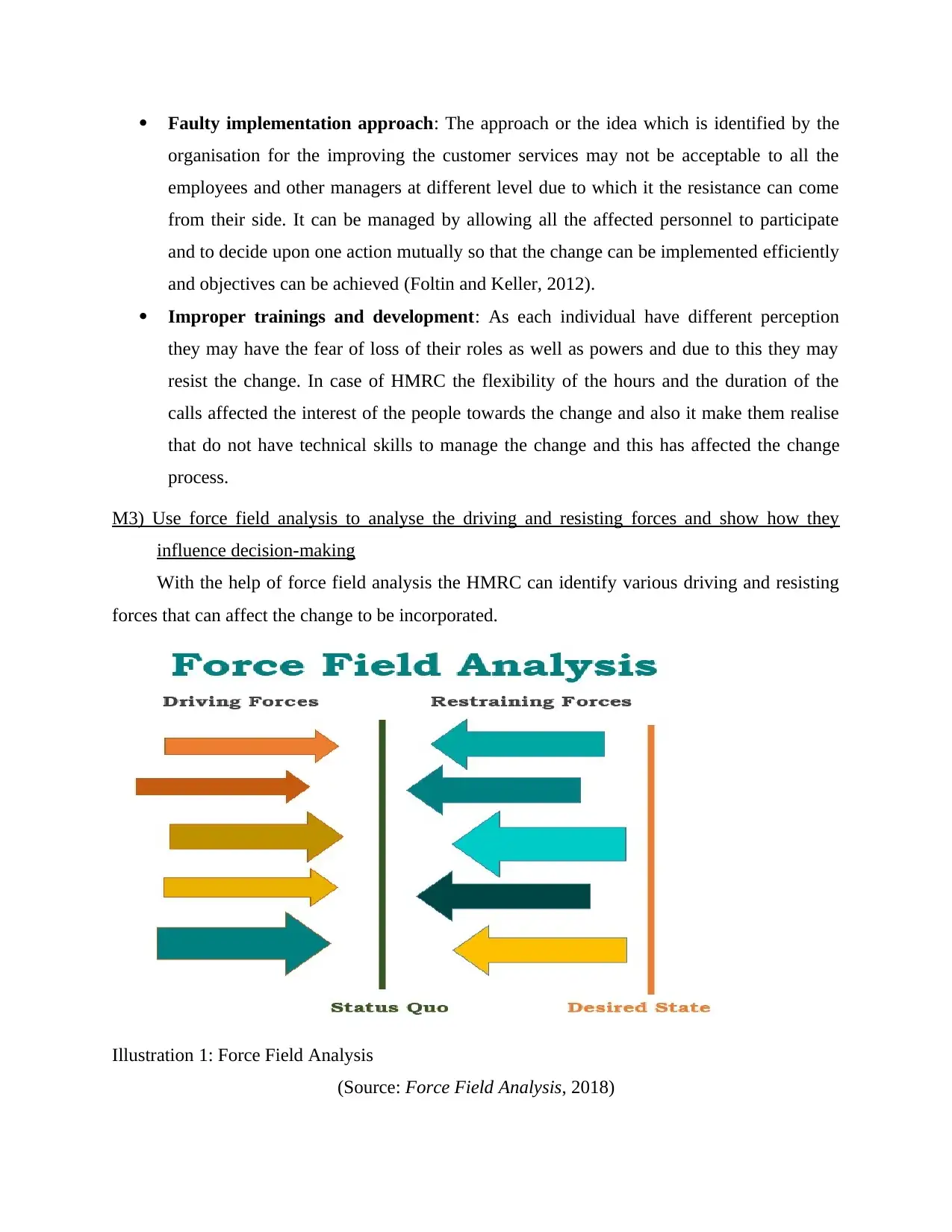
Faulty implementation approach: The approach or the idea which is identified by the
organisation for the improving the customer services may not be acceptable to all the
employees and other managers at different level due to which it the resistance can come
from their side. It can be managed by allowing all the affected personnel to participate
and to decide upon one action mutually so that the change can be implemented efficiently
and objectives can be achieved (Foltin and Keller, 2012).
Improper trainings and development: As each individual have different perception
they may have the fear of loss of their roles as well as powers and due to this they may
resist the change. In case of HMRC the flexibility of the hours and the duration of the
calls affected the interest of the people towards the change and also it make them realise
that do not have technical skills to manage the change and this has affected the change
process.
M3) Use force field analysis to analyse the driving and resisting forces and show how they
influence decision-making
With the help of force field analysis the HMRC can identify various driving and resisting
forces that can affect the change to be incorporated.
Illustration 1: Force Field Analysis
(Source: Force Field Analysis, 2018)
organisation for the improving the customer services may not be acceptable to all the
employees and other managers at different level due to which it the resistance can come
from their side. It can be managed by allowing all the affected personnel to participate
and to decide upon one action mutually so that the change can be implemented efficiently
and objectives can be achieved (Foltin and Keller, 2012).
Improper trainings and development: As each individual have different perception
they may have the fear of loss of their roles as well as powers and due to this they may
resist the change. In case of HMRC the flexibility of the hours and the duration of the
calls affected the interest of the people towards the change and also it make them realise
that do not have technical skills to manage the change and this has affected the change
process.
M3) Use force field analysis to analyse the driving and resisting forces and show how they
influence decision-making
With the help of force field analysis the HMRC can identify various driving and resisting
forces that can affect the change to be incorporated.
Illustration 1: Force Field Analysis
(Source: Force Field Analysis, 2018)
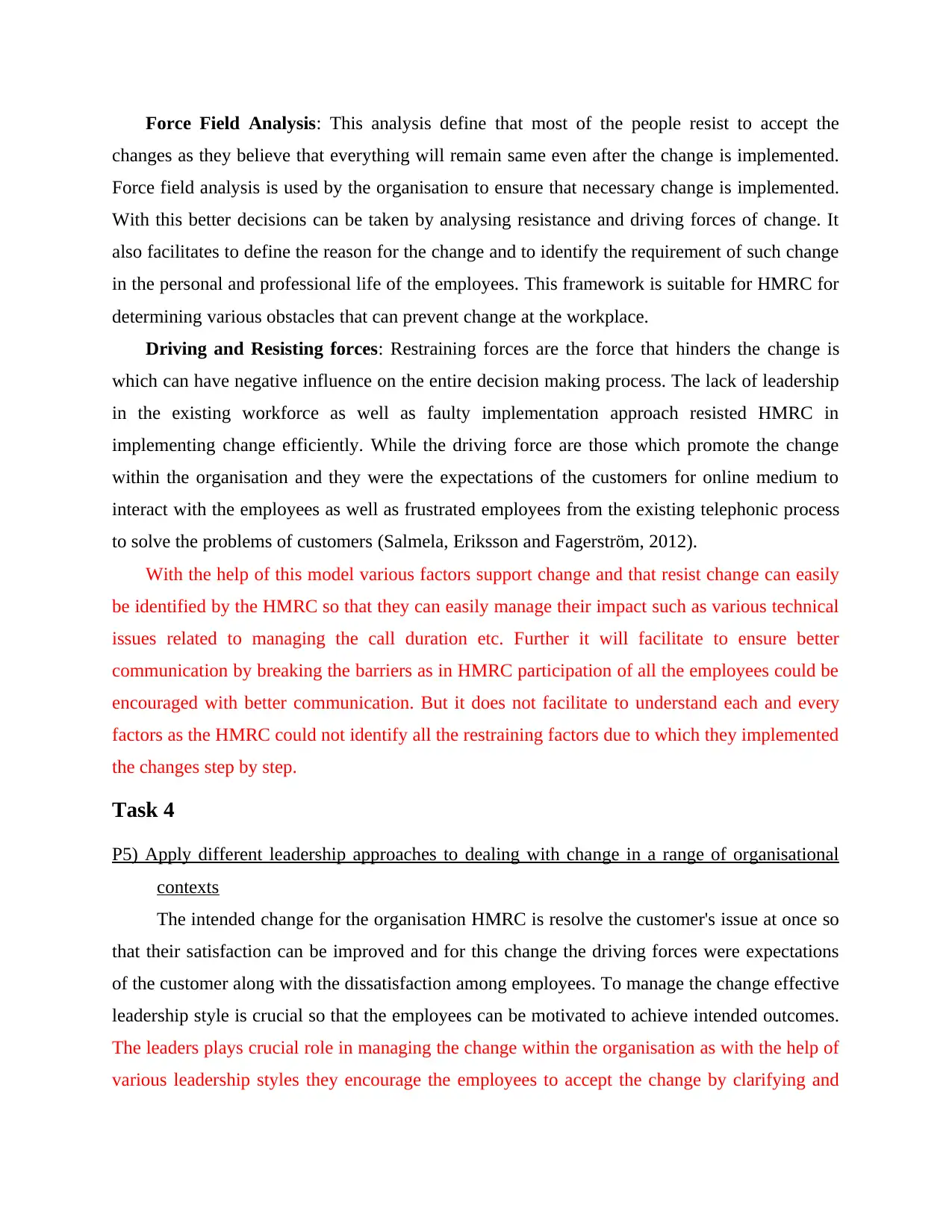
Force Field Analysis: This analysis define that most of the people resist to accept the
changes as they believe that everything will remain same even after the change is implemented.
Force field analysis is used by the organisation to ensure that necessary change is implemented.
With this better decisions can be taken by analysing resistance and driving forces of change. It
also facilitates to define the reason for the change and to identify the requirement of such change
in the personal and professional life of the employees. This framework is suitable for HMRC for
determining various obstacles that can prevent change at the workplace.
Driving and Resisting forces: Restraining forces are the force that hinders the change is
which can have negative influence on the entire decision making process. The lack of leadership
in the existing workforce as well as faulty implementation approach resisted HMRC in
implementing change efficiently. While the driving force are those which promote the change
within the organisation and they were the expectations of the customers for online medium to
interact with the employees as well as frustrated employees from the existing telephonic process
to solve the problems of customers (Salmela, Eriksson and Fagerström, 2012).
With the help of this model various factors support change and that resist change can easily
be identified by the HMRC so that they can easily manage their impact such as various technical
issues related to managing the call duration etc. Further it will facilitate to ensure better
communication by breaking the barriers as in HMRC participation of all the employees could be
encouraged with better communication. But it does not facilitate to understand each and every
factors as the HMRC could not identify all the restraining factors due to which they implemented
the changes step by step.
Task 4
P5) Apply different leadership approaches to dealing with change in a range of organisational
contexts
The intended change for the organisation HMRC is resolve the customer's issue at once so
that their satisfaction can be improved and for this change the driving forces were expectations
of the customer along with the dissatisfaction among employees. To manage the change effective
leadership style is crucial so that the employees can be motivated to achieve intended outcomes.
The leaders plays crucial role in managing the change within the organisation as with the help of
various leadership styles they encourage the employees to accept the change by clarifying and
changes as they believe that everything will remain same even after the change is implemented.
Force field analysis is used by the organisation to ensure that necessary change is implemented.
With this better decisions can be taken by analysing resistance and driving forces of change. It
also facilitates to define the reason for the change and to identify the requirement of such change
in the personal and professional life of the employees. This framework is suitable for HMRC for
determining various obstacles that can prevent change at the workplace.
Driving and Resisting forces: Restraining forces are the force that hinders the change is
which can have negative influence on the entire decision making process. The lack of leadership
in the existing workforce as well as faulty implementation approach resisted HMRC in
implementing change efficiently. While the driving force are those which promote the change
within the organisation and they were the expectations of the customers for online medium to
interact with the employees as well as frustrated employees from the existing telephonic process
to solve the problems of customers (Salmela, Eriksson and Fagerström, 2012).
With the help of this model various factors support change and that resist change can easily
be identified by the HMRC so that they can easily manage their impact such as various technical
issues related to managing the call duration etc. Further it will facilitate to ensure better
communication by breaking the barriers as in HMRC participation of all the employees could be
encouraged with better communication. But it does not facilitate to understand each and every
factors as the HMRC could not identify all the restraining factors due to which they implemented
the changes step by step.
Task 4
P5) Apply different leadership approaches to dealing with change in a range of organisational
contexts
The intended change for the organisation HMRC is resolve the customer's issue at once so
that their satisfaction can be improved and for this change the driving forces were expectations
of the customer along with the dissatisfaction among employees. To manage the change effective
leadership style is crucial so that the employees can be motivated to achieve intended outcomes.
The leaders plays crucial role in managing the change within the organisation as with the help of
various leadership styles they encourage the employees to accept the change by clarifying and
⊘ This is a preview!⊘
Do you want full access?
Subscribe today to unlock all pages.

Trusted by 1+ million students worldwide
1 out of 16
Related Documents
Your All-in-One AI-Powered Toolkit for Academic Success.
+13062052269
info@desklib.com
Available 24*7 on WhatsApp / Email
![[object Object]](/_next/static/media/star-bottom.7253800d.svg)
Unlock your academic potential
Copyright © 2020–2025 A2Z Services. All Rights Reserved. Developed and managed by ZUCOL.





